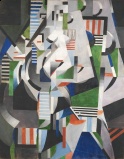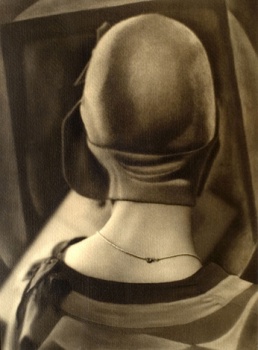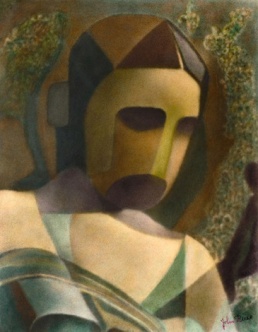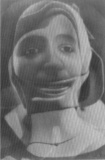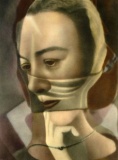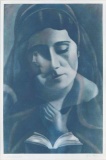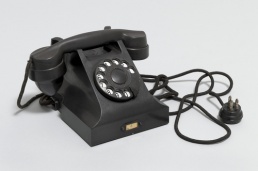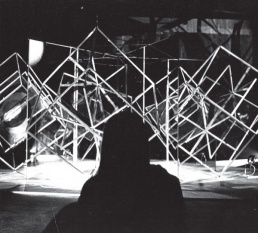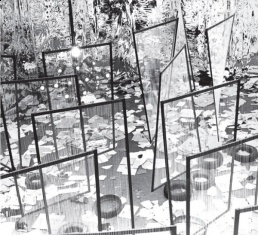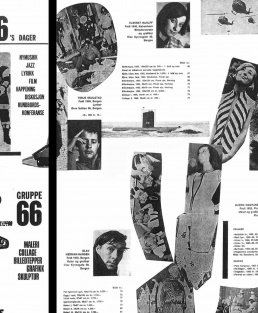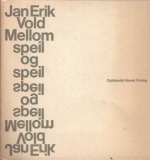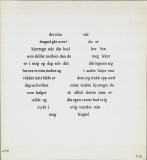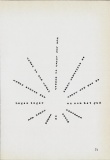Norway
Contents
Avant-garde, Modernism
Cubist and constructivist painting
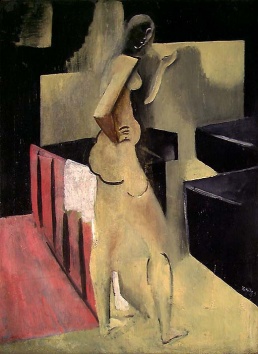
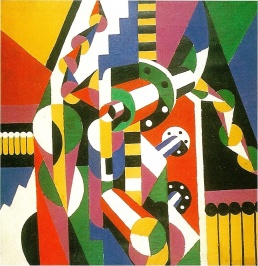
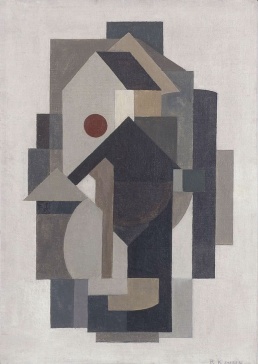


Several Norwegian painters got acquainted with abstract art during their studies in Paris in the 1910s and 20s. They participated in a number of exhibitions in Norway and internationally, showing their works next to the likes of Léger, Picasso, Gris, Mondrian and Sonia and Robert Delaunay.
- Thorvald Hellesen, moved to Paris in 1912 where he married and settled down. From around 1914 his works read the influence by Orphism and a constructive form of Cubism approaching the non-figurative. Some of the works from 1916 are heavily influenced by Picasso and his synthetic cubism. From 1915 onwards he often included elements of collage in compositions, eg. silver paper, pieces of wood and other objects. Around 1920 Hellesen developed formal language in the directon of Léger's "machine cubism", which paralleled in pursuit of applied arts, since he worked in pattern drafting for textile and wallpaper industry, and also carried out posters and theatrical projects. Later he got involved, like many other artists in Paris of the 1920s, in decoration works for the new avant-garde architecture. Works, [35], [36].
- Ragnhild Kaarbø studied with the early fauvist Kees van Dongen (1912–14) in Paris, where she lived again in 1920-30. She continued her studies with André Lhote (1921–23), at Académie Araujo (1922–23), and with Léger and Ozenfant at Académie Moderne (1925–27). She was among the artists of the Cubist exhibition in Oslo in 1927. After her return to Oslo in the late 1920s she returned to Impressionism. Works, [37].
- Ragnhild Keyser stayed in Paris in 1920-35. She studied with André Lhote (1920–23), at Académie Ranson (1923), Académie Moderne (1922–23, 25), and Académie Araujo (1922–23). Her "non-figurative purist" works were made in the period 1925-27. Works, [38].
- Charlotte Wankel studied from 1910 at the well-established Académie Henri Matisse, and later at Académie Araujo (1922–23), and with Léger and Ozenfant at Académie Moderne (1925–27/29). In 1922 she draw Le Corbusier-inspired plan for her mother's family's new house at Blommenholm in Bærum. Her work from 1927-29 draws a lot from purism. She participated in the 1927 Cubist exhibition in Oslo and held another two solo shows in her homeland in 1930 and 1934, however harsh criticism in the press triggered her gradual withdrawal from the art world. Works, [39].
Thorvald Hellesen, Komposisjon, 1920. [1]
Ragnhild Kaarbø, Komposisjon med hode, 1924-27. [2]
Ragnhild Kaarbø, Komposisjon, 1926-27. [3]
Exhibitions
- Thorvald Hellesen's retrospective in Tivoli exhibition building, Oslo, 1919, with his works of the past 7-8 years.
- Exposition Internationale L'Art d'Aujourd'hui exhibition, Paris, December 1925. The first major international exhibition of avant-garde art after the World War I. Exhibiting artists included Ragnhild Keyser, Charlotte Wankel, as well as other Scandinavian artists (Otto Carlsund, Waldemar Lorentzon, Vera Meyerson, Bengt Österblom, Franciska Clausen). [40]
- Exhibition at the Galerie d'Art Contemporain, Paris, June 1926, with paintings by Kaarbø, Keyser, Carlsund and Clausen. [41]
- Major exhibition at the Galerie Aubier, Paris, March 1927, with works by Kaarbø, Carlsund and Clausen. [42]
- Otte skandinaviske kubister [Eight Scandinavian Cubists] exhibition, Kunstnerforbundet [Artists' Association], Oslo, 1927. With the works by eight students of Academie Moderne in Paris, including Kaarbø and Wankel. Met with bewildered reactions from art critics calling for boycott of the Association.
- Unionalen exhibitions (1927-31). Unionalen was an association of Scandinavian artists, primarily students of Henri Matisse, who returned from their stay in Paris. "The Maison Watteau academy in Paris had became an important meeting place both for Scandinavian and international avant-garde artists after World War I. When the Parisian art market collapsed in the late 1920s several Scandinavian artists decided to return to their respective countries. However, they wanted to hold on to the 'Parisian experiences'. Hence, the Unionalen was invented to be an ambulant Scandinavian substitute to the Paris node. Unionalen was initiated during a gathering in Henrik Sørensen’s studio in Paris in 1926. The main idea was to establish a continuation of the artist community and network in Paris through more or less casual events. Nils Dardel designed the flag of Unionalen with yellow, red and blue dices on white background to be hoisted in front of the entrance on each venue. The first show opened in Stockholm, 1927, the next in a dismantled bank building in Oslo, 1928, and the last and most successful at Charlottenburg in Copenhagen in 1931, with more than 20 000 visitors. The artists behind the drive insisted on an international and open attitude and hoped also to produce an event in Paris. This became impossible because of political reasons." (from Kari Brandtzæg's paper abstract [43]).
- Charlotte Wankel's first solo exhibition in Norway, 1930.
- Ragnhild Keyser's first solo exhibition, Blomqvists, Oslo, 1932.
- Charlotte Wankel's second solo exhibition in Norway, 1934.
- Female Pioneers - New Voices exhibition at Lillehamer Kunstmuseum, 2013. With works by Keyser and Wankel.
Literature
- Unionalen 5-27 februari 1927, Stockholm: Liljevalchs konsthall, 1927, 39 pp. Catalogue.
- Harald Hansen (ed.), Unionalen: Stockholm, Oslo, København, Copenhagen, 1931, 91 pp.
- Hilde Mørch, Tre norske avantgardekunstnere i 1920-årene. Ragnhild Keyser (1889–1943), Ragnhild Kaarbø (1889–1949), Charlotte Wankel (1888–1969), Oslo, 1993. Dissertation. (in Norwegian)
- Per Bäckström, Bodil Børset (eds.), Norsk Avantgarde, Oslo: Novus, 2011, 790 pp. ISBN 9788270996490. (in Norwegian) [44]
- Tania Ørum, Ping Huang, et al. (eds.), A Cultural History of the Avant-Garde in the Nordic Countries 1900-1925, Amsterdam/New York: Rodopi, 2012, 680 pp. ISBN 978-90-420-3620-8. [45], Preview, Review.
- Frank Claustrat, "Nordic Writers and Artists in Paris Before, During and After World War I", pp 129-146. [46]
- Ellef Prestsæter, "The Avant-Garde as Network. Interview with Tania Ørum", Kunstkritikk, 23 April 2012.
- Line Ulekleiv (ed.), Kvinnelige pionerer - Nye stemmer, Lillehammmer: Lillehammmer Kunstmuseum, 2013, 20 pp. Catalogue.
- Hilde Mørch on Ragnhild Keyser.
- Kari Brandtzæg is currently writing her dissertation at the University of Oslo on aesthetics and politics in the inter-war period, investigating the international orientations among Norwegian socially engaged artists in the 1920s and 30s. [47]
Modernist magazines
 Cover of Exlex 1:2 (19 Feb 1919), Ragnvald Blix, "Home from the Civilisation". [18] |
 Cover of Plan 3, 1935. [19] |
- Poets such as Alf Larsen, Henrik Rytter, Olav Aukrust, and Kristofer Uppdal, and the painter Per Krogh, had their work published in the Copenhagen-based magazine Klingen. The poems of Rytter, Aukrust and Uppdal (Issues 8, 9, 10-12, 1918) were all written in an experimental versions of nynorsk [New Norwegian], from 1885 onwards Norway's second official written language. [48]
- Exlex [Lawless], satirical weekly, Feb 1919-Dec 1920, 96 issues; issue 26 (Aug 1919) and onwards were published in Copenhagen. The second year the magazine used a slogan "The only Scandinavian Magazine for Art and Satire". Its founding editor, illustrator Ragnvald Blix, had had his formative years in Copenhagen, Paris, and Munich (he worked in the satirical weekly Simplicissimus for over ten years), and recruited artists and writers from across Scandinavia in the hope of building a stronger and better Scandinavian community--primarily with the ambition of creating a high-quality satirical magazine. Contributors included illustrators Olaf Gulbransson, Anton Hansen, Adolf Hallman, Ossian Elgström and Robert Storm Petersen, and the poet Herman Wildenvey. [49] [50]
- PLAN. Magazine for Housing and Architecture was published in four editions, 1933-36, in Oslo by the Socialist Architects' Society. Inspired by its Danish counterpart Kritisk Revy [Critical Review] (1926-28), Swedish Byggmästaren, as well as by Le Corbusier's functionalism and Bauhaus. [51]
- Literature
- Eirik Vassenden, "Norway: The Province and its Metropolites", in The Oxford Critical and Cultural History of Modernist Magazines, vol. 3 (Europe, 1880-1940), New York: Oxford University Press, 2013, pp 643-665. [52]
John Olav Riise's photography
John Olav Riise worked as a professional photographer from the 1920s up till 1950s. His work utilised aspects of Cubism, Surrealism, Expressionism, Abstraction and Neo-Classicism of Ingres; combined up to five negatives in one photograph and used hand-applied colours. He participated annually at The International Salon of Photography in Paris from 1924 to 1932. In 1948 he began painting, participating in the Autumn Exhibition in 1970. [53] [54] [55] [56]
Oslo's Fotogalleriet held an exhibition of his work in 1994. In 2006, Henie-Onstad Art Centre mounted his retrospective, which traveled to New York the next year[57], and was followed by another one in 2011[58].
- Works
- Literature
- Robert Meyer, John Riise - fra fotografi til maleri i Skandinavisk kunst og fotografi, Oslo, 1988. (in Norwegian)
- Eva Klerck Gange, John Riise: En idéhistorisk vurdering. Hovedoppgave ved institutt for idéhistorie, Oslo University, 1992. Dissertation. (in Norwegian)
- John Olav Riise: Fotografier, Henie-Onstad Art Centre, 2006, 96 pp. Catalogue with an essay by Eva Klerck Gange. (in English/Norwegian) [59].
Jean Heiberg's bakelite telephone design
Jean Heiberg lived in Paris in 1905-12. He got acquainted with Fauvism and Cubism, and was the first of a number of Norwegian painters who studied under Henri Matisse (1908-10). He is also known for one work in industrial design: when he returned to Norway in 1929, he was commissioned to design a bakelite telephone terminal for Elektrisk Bureau (up till then, telephones had been made out of metal; bakelite was invented in 1909 by Leo Baekeland). Heiberg had produced the huge painted plaster prototype, however it proved to be too difficult to cast in bakelite; and the later model had smooth surface and sharp edges. The phone went into production in 1932 as the Ericsson model DBH 1001, and is claimed as the world's first "hookless" bakelite telephone, that is the first telephone where the cradle, or receiver hook, was integrated into the all-bakelite body. The engineering design of this model was made by Johan Christian Bjerknes. The model was sold throughout Scandinavia, in Britain, Italy, Greece and Turkey, and (through Siemens) in France and the USA; staying in production for over twenty years. See also 25-minute documentary from Arte TV. [60] [61] [62] [63]. Heiberg's works at DigitaltMuseum.no.
Metal prints and Snegrafikk of Rolf Nesch
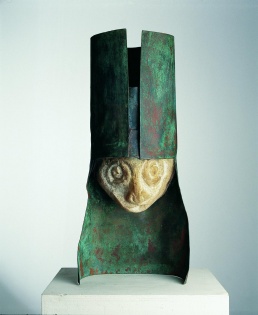
Rolf Nesch was born in Germany, and moved to Norway following the Nazi takeover in 1933. Inspired by Norwegian scenery and working life, he discarded canvas and paintbrushes [64] for good, and turned to printmaking. He developed his own techniques for metal prints [65] and so-called Snegraffik [material pictures] [66], for which he used a range of materials: metal plates, copper wire, wood, stone, glass, mica, rope, nails, and so on. His metal prints include Elbe Bridge I (1932), Snow (1934) in a series of 20 (black and white), 21 metal prints of fisheries off the Lofoten Islands (1936) [67], 10 metal prints inspired by poems of Henrik Rytter (1937); and others. Material pictures [Snegrafikk]: Double Lion of Babylon (1934), Reclining Woman (1934), both large zinc plates with metal wire soldered to them; the three-part Music (1934-35); the high relief and abstracted figures of Peace (1935-36) whose theme is the 1915 Eastern Front; etc. He also created distinctive sculptures, mostly figures in stone and bronze [68]. 1938 saw his first exhibition of material pictures, held at the premises of Kunstnerforbundet in Oslo. Nesch's metal-plate technique is described by Sidsel Helliesen of the National Museum; Eivind Otto Hjelle writes about his material pictures. His work provided inspiration for the abstract artist Olav Strømme and many other Norwegian Modernists in the 1930s.
Kurt Schwitters in Norway
Kurt Schwitters fled to Norway in January 1937. The same year he started a second Merzbau in Lysaker near Oslo, but abandoned it in June 1940 when the Nazis invaded, and fled to Scotland. His stay in Norway passed mostly unnoticed. The Merzbau was subsequently destroyed in a fire in 1951. His hut on the Norwegian island of Hjertøya, near Molde, is also frequently regarded as a Merzbau. For decades this building was more or less left to rot, but measures have now been taken to preserve the interior. The book Schwitters in Norway was published in 2009 (see below). Since 2010, Henie-Orstad Art Centre hosts the Kurt Schwitters room, being the largest permanent presentation by the artist's works outside Germany.
- Literature
- Karin Orchard (ed.), Schwitters in Norway, Hatje Cantz, 2009, 212 pp. ISBN 978-3-7757-2420-3. (in English and Norwegian). With texts by Karin Hellandsjø, Karin Orchard, Isabel Schulz, Terje Thingvold, and Sverre Wyller. Excerpt. [69] [70]
Fabrikken
During the occupation of Norway by Nazi Germany, Jean Heiberg and Axel Revold were fired from their professorships at the Norwegian National Academy of Fine Arts in autumn 1941. Eventually they secretly started running an undercover art academy in Oslo, called Fabrikken [The Factory], as its first location was in a closed corset factory Norena (at Pilestredet 15). They were later located at Lauritz Falk's home at Frogner, at Johannes Sejersted Bødtker's studio at Holmenkollen, and in autumn 1944 in a warehouse in Thereses gate.
Research today
Scholars who have researched Norwegian avant-garde and modernism include Hilde Mørch (Kunsthistorisk Prosjektsenter), Kari Brandtzæg (UiO Oslo), and Eirik Vassenden (HiB Bergen).
In 2004, the large Nordic Network of Avant-Garde Studies research project started with the aim to produce a series of four international conferences on Nordic avant-garde art, each to be followed by a book. The first was dedicated to analysis of the period 1900-25 and was held in Copenhagen in 2009 (with a volume published in 2012, see above); the second one (1925-50) is to be held again in Copenhagen, in October 2013.
Electroacoustic and experimental music
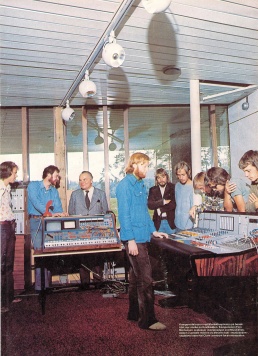

Composers
- Gunnar Sønstevold experimented with electronic instruments in his music for Shakespeare's The Tempest at the Norwegian Theatre in 1957; adhered to Schoenberg's twelve-tone technique.
- In the late 1960s, Arild Boman acquired DIMI-T synthesizer and collaborated with the Finnish electronic art pioneer Erkki Kurenniemi at the University of Oslo [71]. His computer music works from 1967-69 were presented at the Norwegian pavillion at the Paris Biennial in 1969 (see below).
- Arne Nordheim, Norway's most celebrated composer after Edvard Grieg. NRK documentary (44 min, in Norwegian).
- Rolf Aamot, electronic painter and tonal-image composer. [72]
- Bjørn Fongaard, known for his works for a specially designed 'micro-intervallic' guitar.
- Sigurd Berge
- Kåre Kolberg created a computer music piece in 1973, among his other works.
- Hal Clark, founding director of Electronic Music Studio; lived in Norway throughout the 1970s.
- Knut Wiggen worked in Sweden; founding director of Stockholm's Electronic Music Studio.
Initiatives
- The Norwegian section of the International Confederation of Electroacoustic Music (NICEM).
- Norwegian Center for Technology in Music and the Arts (NOTAM), established in 1992. Until 2008 it operated under the name Norwegian Network for Technology, Acoustics and Music.
Events
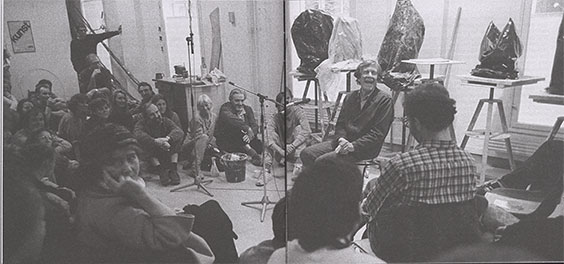
Trailer for the upcoming documentary Subharchord – A Child of the Golden Age by Ina Pillat. |
- Performances of Bjørn Fongaard's Uranium 235 for orchestra in Oslo and Reykjavik, 1965-66. None of the performances took place because the musicians were unable to read the notation (Fongaard was developing his notation system, inspired by modernists such as Hindemith, Schoenberg and Webern). This later led the composer to peform his music on specially designed guitar. See his page for more.
- 1968, first performance of Arne Nordheim's electronic production, Solitaire, with lightning by Terje Moe.
- In 1968, a Subharchord electronic sound generator was smuggled to Norway from East Berlin (while there were only about seven ever built). The head of NRK's music department, Gunnar Sønstevold, used the instrument in NRK studio for electronic music. The instrument could produce sounds and timbres for various television productions. However, it is unclear how it was actually used. After a while, the instrument was moved from the studio to the home of Sønstevold. Today it is part of the collection of the Norwegian Museum of Science and Technology. [73]. Since 2010, Ina Pillat is working on the documentary Subharchord – A Child of the Golden Age. Trailer, [74].
- Electronic music concert-series Elektrofoni, Henie-Onstad Art Centre, 1968-83.
- Seminar and concert with Karlheinz Stockhausen in the Henie-Onstad Art Centre, 1969.
- Haagen Ringnes’ TV-show Åpen Post on the subject popmusic in Autumn 1969 featured actress and singer Elisabeth Grannemann's parody performance which included throwing dishes and yelling, with direct reference to composer Arne Nordheim's music. This eventually resulted in a double-LP with avant-garde pop songs from five composers, entitled Popofoni (see below). More detailed account of the story, and another one in Norwegian.
- World premiere of Mauricio Kagel's Exposition on the tenth anniversary of the Henie-Onstad Art Centre, 1978.
- Week-long visit of John Cage in Oslo, November 1983. His stay was well documented in photo, video and audio recordings, he was interviewed by all the major newspapers, as well as by Eivind Solås for NRK Television. A special pamphlet was printed for the event, containing articles by amongst others Kåre Kolberg and Kjell Samkopf. Shortly after his stay the Norwegian journal of new music, Ballade, published a special Cage edition. Recordings of the event were published in 1984 as an unusual 10-tape suitcase John Cage in Norway. [75]
- John Cage: The Anarchy Of Silence exhibition, Henie-Onstad Art Centre, February-May 2010. A book with CD was published on the occasion. [76]
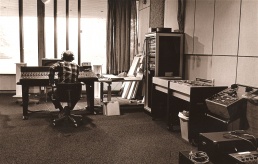
Studio
- Norwegian Studio for Electronic Music (NSEM), 1975-78. Founded by Hal Clark and Arne Nordheim at the Henie-Onstad Art Centre, while it was run together with the Music Academy, Norwegian Broadcasting Bureau (NRK), and Composers Union. As a result of controversy it moved to the Academy, and soon dissolved.
Releases



- Arne Nordheim, Contemporary Music From Norway, Philips (839.250 AY), LP, 1967. Compositions: Canzona Per Orchestra; Epitaffio Per Orchestra E Nastro Magnetico; Response I For Two Percussion Groups And Magnetic Tape. [77]. Epitaffio later appeared on Music Of Arne Nordheim, Decca (HEAD 23), LP, 1979, [78], and on Epitaffio / Doria / Greening, Aurora (NCD-B 4931), CD, 2000, [79].
- Bjørn Fongaard, Alfred Janson, Arne Nordheim, Musique électronique norvégienne, Philips (DSY 836 896), LP, 1968, [80]. Compositions: Nordheim's Epitaffio and Response I; Janson's Canon; Fongaard's Galaxe, op 46, 1966. UK version, Philips (4FE8002), 1968, [81]. US reissue, Limelight (LS 86061), 1970, [82]. [83].
- Bjørn Fongaard's composition Homo Sapiens appeared on the compilation Nordic Music Days 1968, Vol 3, EMI & Odeon, LP, 1969. [84].
- Arne Nordheim, Colorazione / Solitaire / Signals, Philips (845 005 AY), LP, 1969. Compositions: Colorazione; Solitaire; Signals. Realised at Studio Eksperymentalne, Warsaw. [85].
- VA, Popofoni, Sonet (SLP 1421/22), 2-LP, 1973. Contains tracks by Gunnar Sønstevold, Nordheim, Alfred Janson, Kåre Kolberg, and Terje Rypdal. "Holy grail of Norwegian free-jazz and electronic music." [86]. Reissued by Prisma Records (PRISMALP001), 2-LP, 2012, [87], [88].
- Arne Nordheim, Sigurd Berge, Bjørn Fongaard, Contemporary Music From Norway, Philips (6507 034), LP, 1973. Tracklist: Nordheim, Fem Osaka-Biter [Five Osaka Fragments]; Berge, Månelandskap [Moon Landscapes]; Berge, Munnharpe [Jew's Harp]; Fongaard, The Space Concerto For Piano And Tape; Berge, Humoreske [Humoresque]; Berge, Eg Beisla Min Støvel [I Harnessed My Boot]; Berge, Erupsjon [Eruption]. [89].
- Arne Nordheim, Electronic Music, Philips (6507 042), LP, 1974. Compositions: Warszawa, 1970; Pace, 1970; Lux et tenebrae, 1970 (concrete and electric sounds for Osaka Expo 70). Recorded at Studio Eksperymentalne, Warsaw. [90]. Reissued by Norwegian Composers (NC 3842), 1985. [91].
- Kåre Kolberg, Nova, Prisma Records (PRISMA CD705), CD, 2009. Contains Nova, 1972 (composed for a multimedia installation, see above). [95], [96].
- Arne Nordheim's Colorazione For Hammond Organ X-66, Percussion, Time-Delay, Ring Modulators And Filters (Version 1982) appeared on his Colorazione, Philips (410 470-1), LP, 1983. Realised with Eugeniusz Rudnik (effects) and Kåre Kolberg (hammond organ). [97]
- Arne Nordheim, Dodeka, Rune Grammofon (RCD 2030), CD, 2003. Contains 12 tracks. [98]
- Sigurd Berge, Early Electronic Works, Prisma Records (PRISMA CD708), CD, 2010. The disc contains previously unreleased pieces Eg beisla min støvel, Preludium, Ritual, Sørgemusikk, and Erupsjon; the musique concrète piece Delta, which Berge also used in a collaboration with the avant-garde jazz trio Svein Finnerud in 1970; and the excerpts from electronic music composed for the multimedia installation Blikk (see above). [99], [100], [101].
- Bjørn Fongaard, Elektrofoni: Works For Micro Intervallic Guitar 1965-1978, Prisma Records (PRISMA CD711), 3-CD & 5-DVD, 2010. [102], [103]. The Wire review.
- Rolf Aamot, Tonal Image Films 1968-1991, Prisma Records, CD, 2011. Works: Actio, 1980; Kinetisk Energi Part 1 & 2, 1968; Nordlys [Northern Lights], 1991; Progress, 1972; Viisuelt, 1971. The disc contains audio part to Aamot's tonal image films. The music consists of abstract sounds and movements from different electronic sources, interacting with pre-recorded and prepared acoustic instruments and human voices. [104], [105].
- Kåre Kolberg, Omgivelser & Portando, Prisma Records (prismaCD714), CD, 2011. Contains two compositions: Omgivelser, recorded in Studio Eksperymentalne, Warsaw, 1970; and Portando, recorded at Henie-Onstad Art Centre Studios, 1987. [106], [107]
- Kåre Kolberg, Electronic Works 1970-1973, Prisma Records (PRISMALP002), LP, 2012. Contains three works: Nova, 1972 (composed for a multimedia installation, see above), Omgivelser, 1970, Keiserens Nye Slips [The Emperor's New Tie], 1973 (recording previously appeared on a 1980 compilation by Philips[108] and Kolberg's 1988 compilation by Aurora[109]). [110], [111].
- VA, I Want The Beatles To Play At My Art Centre, Prisma Records (P004), 2-LP, 2012. Contains compositions by Nordheim, Berge, Fongaard, Kolberg, Hal Clark, John Cage, Magne Hegdal and others. With a DVD. [112], [113], [114].
- Hal Clark, Electro-Acoustic Works 1974-75, Prisma Records (PRISMACD716), CD, 2013. [115], [116].
Literature and references
Interview with Hal Clark about the Electronic Studio and music scene in Norway of the mid-1970s, sound recording, KPFA, 52 min, February 1975.
- Hal Clark, The Norwegian Studio for Electronic Music: A Comprehensive Instruction Guide, Høvikodden: Norsk Studio for Elektronisk Musikk, 48 pp.
- Hal Clark, "The Norwegian Studio for Electronic Music", AES 50 (March 1975). [117]
- Jøran Rudi, "International Electroacoustics in Norway - This Site Under Construction", Contact! 9.2 (Spring 1996). (in English and French)
- Hal Clark, "Norges første lydstudio", in Høvikodden Live 1968-2007, 2007. (in Norwegian). Excerpt.
- "Various ‘Eh bien, la Norvège…’", Continuo blog, 14 September 2009.
- John Cage in Norway, Høvikodden: Henie-Onstad Art Centre, 2010, 64 pp. With a CD. Dedicated to Cage's visit to Oslo in November 1983. [118], [119], [120].
- Andreas Bergsland, "Arne Nordheim og den tidlige elektroakustiske musikken i Norge", in Norsk avantgarde, eds. Per Bäckström and Bodil Børset, Oslo: Novus, 2011, pp 229-242, 705-708. (in Norwegian)
- Tilman Hartenstein, "Maskinsång från världens största instrument. Knut Wiggen, Fylkingen, EMS og Musicbox", in Norsk avantgarde, eds. Per Bäckström and Bodil Børset, Oslo: Novus, 2011, pp 247-262, 708. (in Norwegian)
- Tonje Tafjord, Ny Musikk i historie og endring: Samtidsmusikken sitt liv i Noreg frå Pauline Hall til Grønland Kammermusikkfestival, Trondheim: NTNU, 2011. Master's Thesis. (in Norwegian)
- Lars Mørch Finborud, Mot det totale museum; Henie Onstad kunstsenter og tidsbasert kunst 1961-2011, Oslo: Forlaget, 2012, 305 pp. ISBN 9788275476041 (in Norwegian) [121] [122] [123]
- Lars Mørch Finborud (ed.), Arne Nordheim, ingen -ismer for meg, takk!, Oslo: Orfeus, 2013. ISBN 9788293140252. With texts by Paal-Helge Haugen, Ole Robert Sunde, Ola Nordal, Maja S.K. Ratkje, Rob Young, Lars Mørch Finborud, Ingvild Krogvig, Asbjørn Tiller and Asbjørn Blokkum Flø. [124]
- Yrke: Komponist [Occupation: Composer], a documentary film about Arne Nordheim made by Istvan Korda Kovacs, 1 hour, 1974. Included on Arne Nordheim, Selected Works for Television 1967-1974, Prisma Records, DVD, 2013.
Geometric abstraction, Neo-constructivism, Op art, Kinetic art

From the mid-1960s the optical and kinetic forms of expressions were shown at the Kunstnernes Hus in Oslo, particulary during the short-lived chairmanship of the leading experimental, radical left-winger Morten Krohg (1967-69), and at the Henie-Onstad Art Centre at Høvikodden which opened in 1968.
Artists and works
- During their tenure as professors at the Norwegian Institute of Technology in Trondheim, Arne E. Holm and Arne Korsmo employed a number of artists at their Architecture Departments (1947-78 and 1956-68). Consequently, inspired by the Catalan avant-garde group Dau al Set, Ramon Insern Solé triggered formation of a loose art group with his fellow art teachers. Besides him, Gruppe 5 (1961-80) counted Lars Tiller, Halvdan Ljøsne, Roar Wold and Håkon Bleken. Their formalist-leaning work included painting, collages and figurative experiments. In 1966 the group held a show at Kunstnernes Hus in Oslo. One work, Bleken's Stormen [The Storm] from his charcoal drawing series Fragmenter av sannheten [Fragments of Truth], draws parallel between the complicated technical progression from press photograph to drawing and the changes in the mind of a psychotic person. [125]
- Odd Tandberg was the first in Norway to try to create mobile visual images using electric motor-driven plastic and glass elements.
- Siri Anker Aurdal's neo-constructivist sculptural/social space was presented in 1968; to be reconstructed in 2013 for an exhibition in Stavanger [126].
- Irma Salo Jæger's geometrical installations of polaroid and refractive materials moved the multi-coloured light (Kunstnernes Hus, May 1968). In April-May 1970, her commission, kinetic sculpture Blikk [Glimpses], which used computer-controlled light and lasers, and was made in collaboration with the composer Sigurd Berge and the author Jan Erik Vold, was shown at Høvikodden (Berge's electronic composition was released in 2010, see below). The multimedia piece was so complicated to produce that the engineers Halvor Heier, Birger Komedal & Harald Schiøtz was hired for technical assistance.
- Anders Kjær and Kåre Kolberg's socially critical multimedia installation Nova was presented in the Studio Hall at the Henie-Onstad Art Centre in August 1972. Music of Kolberg played from tape was blended together with a sophisticated play of light taking place in a 13x19 metre landscape of glass, rubber tires and piles of paper that the audience could walk through. The composition was released on a CD in 2009 (see below). [127]
Events
- Naum Gabo's lecture at the University at Blindern, 1967.
- Kunstnernes Hus hosted the first kinetic art show in May 1968, including works by Yaacov Agam, Julio Le Parc, Richard Mortensen, Jesus Soto and Victor Vasarely. Irma Salo Jæger presented non-figurative paintings and mobiles in aluminium and acrylic.
- Henie-Onstad Art Centre at Høvikodden opened on 23 August 1968, with Ole Hendrik Moe as director. The programme included a selection from their own collections and jazz, electronic music, ballet and films. List of exhibitions, 1969-79.
- Kunst på boks [Art in a Box] at the Henie-Onstad Art Centre showed pop art and the latest production and reproduction methods, Jan-Feb 1972.
Literature
- Susanne Rajka, "Norway in the '60s: Image of a Decade", in The Nordic 60s: Upheaval and Confrontation, Helsinki: Nordic Arts Centre, 1991, pp 156-161.
- Inge Torheim, "Individuelle tendenser og fellestrekk hos kunstnerne i Gruppe 5 1956-1962", University of Oslo, 1994. Thesis. (in Norwegian)
- Lars Mørch Finborud, Mot det totale museum; Henie Onstad kunstsenter og tidsbasert kunst 1961-2011, Oslo: Forlaget, 2012, 305 pp. ISBN 9788275476041 (in Norwegian) [128] [129] [130]
Intermedia, Happenings, Action art
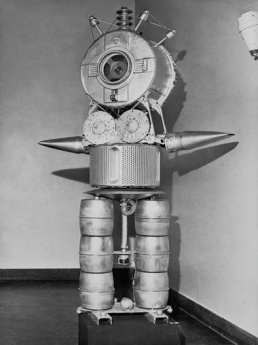

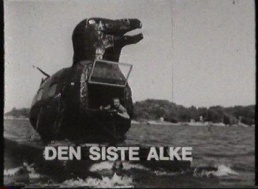
- Critique of technology and environmental activism of Marius Heyerdahl
Marius Heyerdahl studied with George Grosz in New York and at the University of Berkeley, followed by studies and long stays in Sweden, Nigeria, Iraq, England, France and Italy. His work raised concern about the earth's elements, industrialised man and his relationship with nature; Heyerdahl warned against the destruction of nature in his writings and 'technological monsters' made of industrial waste such as parts of canons, cooling system of jet motors or of wasching machines. Golem, 240 cm high burnt iron skeleton with a gas mask, was shown at the UKS Spring Exhibition in 1965, and the same year his Homo Cyberneticus I and II appeared at the special section of the prestigious Autumn Exhibition [131]. Later he created Lucifer (1967), a grinning cow skull. The installations were standing still or moving, producing light signals and mechanical sounds. [132]
Den siste Alke [The Last Auk] (1971) was an extensive environmental activist expedition. Representatives of 'The Ocean Life guardians' (Heyerdahl, Lars Norland and the cinema photographer Jan Horne) visited the major industrial cities of Europe. Contact was made with local environmental organisations and joint demonstrations staged. Routes were drawn up with particular attention to areas suspected of dumping poisons in the North Sea. In many large cities such as Kiel, Frankfurt, Düsseldorf, Rotterdam and London milieu problems were discussed with inhabitants and people from industry. Television, radio and newspapers reported continuously on 'The Auk' project and where it was stopping. Reactions were overwhelmingly positive from residents and workers.
- Gruppe 66
Situationist-influenced Gruppe 66 made some of the first action art and happenings in Norway. Its events saw a mix of poetry, new music, jazz, films, Co-ritus, concrete music, Laterna Magica shadow and puppetry theatre performances using light projection and slides, and participatory events. The motive forces behind the initiative were Jens Jørgen Thorsen from Copenhagen and Lars Grundt. The group was inaugurated at a "living" exhibition in March-April 1966 [133], followed by another ground-breaking exhibition Konkret Analyse in October 1970, both at Bergen Fine Art Association [Kunstforeningen]. The latter exhibition also involved public debates with politicians.
- Gruppe Lyn
In 1971, Gruppe 66 members were among the founders of Gruppe Lyn. This group presented their conceptual and process art works in Oslo Fine Art Society in 1972 – an exhibition that attracted attention and was seen as a breath of fresh air and radically new in the Oslo area. Gruppe Lyn was a pragmatically oriented group without a shared philosophy, founded by Bård Breivik, Stein Rønning, Gerhard Stoltz, Bjørn Krzywinski, Birger Larsen and Arvid Pettersen. They shared workshops and studios and ran the self-organised Galleri 1, later known as Hordaland Artist Centre. [134]
- Samliv exhibition
A group of artists from Bergen, centred around former members of Gruppe 66, initiated a grand collaborative project that aimed to ask, and answer, all of the taboo questions around sexuality, gender, sexual and reproductive health, pornography and sexual politics. Working with medical students, art students, and radical social theorists of all kinds, they produced an 'information exhibition', Samliv. The exhibition opened at Bergen Fine Art Association in January-February 1977 and toured to Tromsø and to Kunstnernes Hus in Oslo. It was both highly controversial, and highly successful, with over 70,000 visitors. [135]
- Other groups, artists and works
The Finnegård circle, the free textile artists (Brit Fuglevaag, Siri Blakstad, Elsebet Rahlff; while Hannah Ryggen was creating socially committed textile works from the 1920s [136]), Gras group (Kjær, Kleiva, Krohg, Radlgruber, Raaen, Storn), Wencke Mühleisen. Several Norwegian artists also participated in the Situationist group Drakabygget in Sweden.
Events
- Nam June Paik's concert at Statens håndverks- og kunstindustriskole, Oslo, September 1961, upon invitation of the composer Finn Mortensen. According to Geir Johnson, Paik said during his other visit to Norway in June 1986 that his Oslo show had been the best in his career as a performance artist. Paik gave a lecture and conducted an hour-long interview for the camera; the video was not broadcasted and has been lost. [137]
- Svein Finnerud Trio with visual artist and poet Trond Botnen and saxophone player Calle Neumann, Multimal, 1971. An album by avant-garde band that was doing different things such as free-jazz, musical theatre, jazz & poetry, working with graphic notation or collaborated with electronic composers. [138] [139]
Literature
- Oddvar Torsheim et al. (ed.), Gruppe 66. Grafikk-lyrikk, Bergen: Gruppe 66, 1966.
- Susanne Rajka, "Norway in the '60s: Image of a Decade", in The Nordic 60s: Upheaval and Confrontation, Helsinki: Nordic Arts Centre, 1991, pp 156-161.
- Susanne Rajka, "Eksperimentelle tendenser i norsk 1960-talls kunst", in Til og fra Norden: Tyve artikler om nordisk billedkunst og arkitektu, eds. Marianne Marcussen and Gertrud With, Copenhagen: Institut for Kunsthistorie, 1999, pp 59-67. (in Norwegian) [140]
- Gerd Hennum, Med kunst som våpen: Unge kunstnere i opprør 1960-1975, Schibsted, 2007, 254 pp. ISBN 9788251624398 (in Norwegian). [141], Review, Review.
- Olav Herman Hansen, "Gruppe 66", Kunst Plus 1 (2011), pp 4-7. (in Norwegian)
- Knut Ove Arntzen, "Gruppe 66, Co-ritus og kunsten som samhandling", Kunst Plus 1 (2011), pp 8-11. (in Norwegian)
- Svein Aamold, "Lek, brudd og tilfeldigheter i skulpturen: Isern og Haukeland, Kleiva og Heyerdahl", in Norsk avantgarde, eds. Per Bäckström and Bodil Børset, Oslo: Novus, 2011, pp 143-158, 697-700. (in Norwegian)
- Elsebet Rahlff, "Min tid med Gruppe 66, Konkret Analyse og Samliv", in Norsk avantgarde, eds. Per Bäckström and Bodil Børset, Oslo: Novus, 2011, pp 281-303, 710-711. (in Norwegian)
- Morten Krohg in conversation with Per Gunnar Eeg-Tverbakk, "Om Grasgruppa og en utålmodighet som ikke lar seg stoppe", in Norsk avantgarde, eds. Per Bäckström and Bodil Børset, Oslo: Novus, 2011, pp 305-327, 711. (in Norwegian)
Scholars
Gerd Hennum, Susanne Rajka, Svein Aamold.
Concrete poetry

Jan Erik Vold's first book mellom speil og speil [Between Mirror and Mirror] (1965) contains several examples of pattern poetry [142]; followed by the conceptual book of concrete poetry blikket [the look] in 1966.
Later, several works of concrete poetry appeared in the anthologies Gruppe 68: Ny norsk diktning, edited by Georg Johannesen, Dag Solstad and Jan Erik Vold (1968) [143], and Åtte fra Bergen (1969) [144].
Jan Erik Vold, mellom speil og speil (cover), 1965. [7]
Jan Erik Vold, mellom speil og speil (page 43), 1965. [8]
Baste Grohn, USA ut av Vietnam, 1968. [9]
Vidar Kristensen, Pyramidedikt, 1968. [10]
Ingvar Moe, ingen sommer, 1968. [11]
Arild Steen, (excerpt), 1969. [12]
Sound art
- Arne Nordheim's sound installations: Solitaire, Lydbar, Poly-Poly (1960s-70s).
- Arnold Haukeland and Arne Nordheim's sound sculpture Ode til lyset [Ode to Light] at Blindsentret in Skjeberg, 1968.
- Blikk [Glimpses] by Irma Salo Jæger, Sigurd Berge and Jan Erik Vold, 1970. (See above)
- Nova by Kjær and Kolberg, 1972. (See above)
- Literature
- Lars Mørch Finborud, Mot det totale museum; Henie Onstad kunstsenter og tidsbasert kunst 1961-2011, Oslo: Forlaget, 2012, 305 pp. ISBN 9788275476041 (in Norwegian) [145] [146] [147]
- Lars Mørch Finborud (ed.), Arne Nordheim, ingen -ismer for meg, takk!, Oslo: Orfeus, 2013. ISBN 9788293140252. [148]
Computer and computer-aided art
- Arild Boman's computer music works Interludium, 1967; Mr. Gorgon, 1968; Diade I, 1969; Diade II, 1969 (all from the series Dialectiques; and the electronic music composition Ecumène, 1969, were presented at the Norwegian pavillion at the Paris Biennial in 1969 [149]. In the 1970s, he had a concert at Kongsberg church with a composition based on biblical texts read into computer from punch cards; and made pioneering experiments with interaction over satellite, working with chamber musicians from Europe and rasta musicians from Jamaica.
- Rolf Aamot's 'electronic painting' and computer graphics, 1970-1980s. Exhibitions: Kunstnernes Hus, Oslo, 1976 (with Bjørg Lødøen); Bergen Kunsthall, Bergen, 1994 (with Bjørg Lødøen); Henie-Onstad Art Centre, 1995; Norsk museum for fotokunst, 2003/2004. [150]
- Blikk [Glimpses], a kinetic sculpture by Irma Salo Jæger, Sigurd Berge and Jan Erik Vold, 1970, used computer-controlled light. (See above)
- Impulser computerkunst [Computerkunst – Impulse; Computer Art], Deutsche Bibliothek and Henie-Onstad Art Centre, 1971. Traveling exhibition managed by The Goethe-Institut (1971-73), with works by the artists from Germany, United States, United Kingdom, Austria and Japan.
- Keiserens Nye Slips [The Emperor's New Tie] electroacoustic music composition by Kåre Kolberg was composed and recorded in 1973 at Electronic Music Studios in Stockholm using a PDP 15/40 computer, and was programmed in EMS-1 computer language developed in the same studio. It was commissioned by Fylkingen, Stockholm.
- Exhibition Arkitekt og Computer [Architecture and Computers] at the School of Architecture [Arkitekturhøyskolen] in Oslo, 1977.
- Atelier Nord, which has operated from 1962 as a graphic arts workshop, started a computer unit in 1993. Electronic art moved to its main focus in 1997 when Kristin Bergaust became the new director. [151]
Television
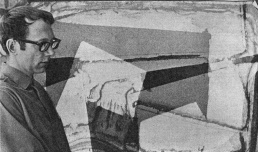

- Rolf Aamot completed a number of courses at the National Film Education / National Study Centre of Film (1969-77) and at the Dramatic Institute in Stockholm (1973). Together with Bjørg Lødøen he created many works for television between 1967 and 1988. His visual music [billedmusik] was initially combined with electronic music, and gradually incorporated theatre, ballet and other elements. Early works: Evolusjon [Evolution] with electronic music by Arne Nordheim (first presented in 1966; TV-broadcasted on 28 May 1967) [152]; Relieff, with electronic music by Bjørn Fongaard and choreography by Edith Roger (21 April 1968) [153]; BSK (1968); Visual (1971); etc. (More).
- Between 1967 and 1974, Arne Nordheim worked on television pieces with Rolf Aamot, but also with Per Kleiva and Norwegian Broadcasting Bureau technicians and directors such as Ole Henrik Moe, Stein-Roger Bull and Rolf Clemens.
- Jan Horne made a work for television called Plym-plym (1968), in collaboration with the composer Kåre Kolberg who was inspired for his work for choir by the poem by Stein Mehren. The work was presented at the Paris Biennial in 1969 [154].
- Releases
- Arne Nordheim, Selected Works for Television 1967-1974, Prisma Records (PRISMADVD002), DVD, 2013. Contains Evolution, 1967 (with Rolf Aamot), and Greening, 1974 (with Per Kleiva and The Oslo Philharmonic Orchestra). [155], [156].
- Literature
- Lars Mørch Finborud (ed.), Arne Nordheim, ingen -ismer for meg, takk!, Oslo: Orfeus, 2013. ISBN 9788293140252. [157]
Video
Artists
 Marianne Heske, Real Unreal, video still from the series All the World's a Stage, 1977. [158] |
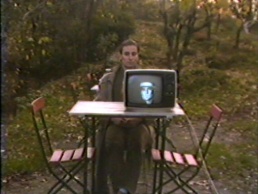 Morten Børresen, The Man on the Screen, 1981, still. [159] |
Terje Munthe, Video Audio Ago, 1983. [160] |
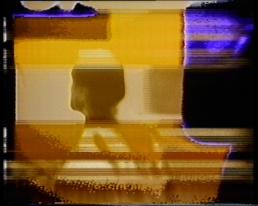 Kjell Bjørgeengen, New York 10010, 1984, still. [161] |
Kristin Bergaust, Linjer [Lines], 1986. |
- Arild Boman's experimental video work was shown at the Autumn Exhibition in 1974. The same year he began teaching video art at the Norwegian State Academy of Art; in 1977 he conducted video art workshop in Lagos. [162]
- Marianne Heske has been working with video since the mid-1970s [163] [164] [165]; later began creating 'video paintings' [166], shown also at the Venice Biennial in 1986 [167] and PS1 in New York, 1988 [168].
- Kjartan Slettemark worked also with video from 1978 onwards.
- Morten Børresen.
- Kjell Bjørgeengen's main domain is video and installation art. Since 1982, he was on several occasions an artist in residence at the Experimental Television Center in the US. He served as Professor in electronic media at the Art Academy of Fine Arts Oslo in 1996-2002. [169] [170]
- Terje Munthe. During his studies at the Art Academy in Trondheim (KiT), in c1981-2 he formed an art group together with Audun Sørsdal, Oddvar Darren, and Lars Paalgard, named it Gruppe 5 in pun-homage to the former Gruppe 5 active in Trondheim in the 1960s (see above), and experimented with video equipment they persuaded the Academy to buy. In 1982-3, Munthe went to study at Nam June Paik's video class at Staatliche Kunstakademie in Düsseldorf (although he learnt more from his assistant than from Paik himself). In 1984, he studied under Phil Orenstein who had computer graphics class at Mason Gross School in New Brunswich, New Jersey, and created his first computer drawings there using Apple and IBM machines. In 1986-89 he worked as director of the Media Workshop at Høvikodden (see below). [171]
- Camilla Wærenskjold after her studies at Art Academy in Trondheim (1979-82) absolved a study stay at Staatliche Kunstakademie in Düsseldorf (1983). She worked with video in the 1980s. [172]
- Kristin Bergaust worked with video since the mid-1980s. [173] [174]
- Brit Bøhme created several videos in the second half of the 1980s.
- Per Maning.
- A K Dolven.
Education initiatives
- Artists' Media Workshop [Kunstnernes Mediaverksted] at Henie-Onstad Art Centre opened in June 1986 (while the idea of video synthesis workshop was discussed already in 1975 at the time when electronic music studio was being created). At the opening, Nam June Paik and Shigeko Kubota delivered a lecture, and gave a long interview to Trond Sigvaldsen and Terje Munthe, although video recording was never broadcasted and has been lost. Video courses were attended by the students from academies in Bergen and Trondheim, from industrial design department of the Arts and Crafts School in Oslo, as well as by Sven Påhlsson who studied at Oslo's Art Academy at the time. The workshop was run by Terje Munthe as director, and Kristin Bergaust. The centre closed down in 1989, and the equipment was acquired by Vega municipality where Munthe ran the Vega School for Art and Culture for children. [175]
- In 1990, the Intermedia Department was established at the Academy in Trondheim with Jeremy Walsh as its first director.
- Atelier Nord in Oslo, which has operated from 1962 as a graphic arts workshop, started a video art workshop in 1993. In the late 1990s it played a central role in video art in the country. [176]
Exhibitions
- Short Film Festival [Kortfilmfestivalen] in Grimstad, which started in 1978, featured video programmes.
- Videokunst [Videoart] at Galleri 1, Bergen, 1984, curated by Jorunn Veiteberg.
- Norwegian video programme compiled by Terje Munthe was shown at DAAD Galerie in Berlin in October-December 1986. Works: Kjell Bjørgeengen, DRIFT (1984); Marianne Heske's video-installation 1 und 2 Januar (1986); Munthe, Tournesol (1986); Oddvar I.N. Daren, A Piece of Landscape (1983); Camilla Wærenskjold, Sigel, metamorfose (1986), and Holy Toy, Hoax (1986). The programme was part of the exhibition N/B OREALIS, and is documented in a catalogue.
- KunstVideo! [ArtVideo] show at Galleri F15 in Moss, 1988, curated by Jorunn Veiteberg.
- Video exhibition at Hordaland Arts Centre, 1989.
- Retrospective: Film and Video Art in Norway, 1960-90, The Stenersen Museum, March-May 2011. Result of a research project Film & Video Art in Norway, 1960-90 conducted by Atopia gallery (see below). Curated by Farhad Kalantary. [177]
- PARADOX. Positions in Norwegian video art 1980–2010, The National Museum in Oslo, February-August 2013. Curated by Eva Klerck Gange.
- Arne Nordheim in the World of Art: No "-Isms" for Me, Please!, Henie-Onstad Art Centre, August 2013-January 2014. Curator: Lars Mørch Finborud.
Research and conservation today
Rickard Borgstrøm based in Trondheim has collected more than 160 video documentations of Nordic performances from 1965 to the present by Hilmar Fredriksen, Kjetil Skøien, Kurt Johannssen, Gruppe 66, Baktruppen, Elisabeth Mathisen, Lotte Konow Lund, Geir Tore Holm and Tommy Olsson. [178]
Attempts to preserve early video (ie. works by Marianne Heske and Kjartan Slettemark) were made in the late 1990s within the Media Culture project headed by Arild Boman.
Since 2007, the artist-run space Atopia in Oslo has been conducting a long-term three-part research Retrospective: Film and Video Art in Norway with Farhad Kalantary as project leader. Researchers include Synne Holst-Pedersen, Linn Lervik and Tone A. Gellein. The first part, which focused on the works produced between 1960 and 1990, resulted in a large-scale exhibition at the Stenersen Museum in 2011 (see above). The second part focuses on the 1990s with a series of exhibitions (2013). [179]
Videokunstarkivet, Norwegian video art archive, was initiated in 2012 by The Arts Council Norway, with Per Platou as project leader. Researchers include Marit Paasche, Ivar Smedstad and Anne Marthe Dyvi.
In 2013, the National Museum hosted a retrospective of Norwegian video art from the period 1980–2010 (see above), with the works by more than twenty artists structured along eight themes. The research and accompanying programme was documented on a blog.
Literature
- Arild Boman, Videogrammer og mediekultur: forskning og kunst, Oslo: Oslo University, 1981, 15 pp.
- Irene Ikdal, "Introduksjon til video som kunstform", in Norsk kunstårbok 1997, Oslo: Kunstnernes informasjonskontor, 1997. (in Norwegian)
- Grøgaard, Morgenstern, Myklebust, Paasche (eds.), Øye for tid. Om video, kunst og virkelighet, Oslo: Unipax, 2004, 133 pp. (in Norwegian)
- Kunstcentralen/Made.no, Arkiv norsk videokunst 1970–2000, Oslo, 2004.
- Mie Berg Simonsen in collaboration with Marit Paasche and Åslaug Krokann Berg, Å bevare det flyktige. En utredning om et nasjonalt arkiv for videokunst, Norsk kulturråd, 2007. (in Norwegian)
- Linn Lervik, Farhad Kalantary (eds.), Retrospective: Film and Video Art Norway, 1960-1990, Oslo: Atopia Stiftelse, 2011, 352 pp. Texts by Farhad Kalantary, Gunnar Iversen, Interview with Jorunn Veiteberg, Irene Ikdal, Lorella Scacco, Nicky Hamlyn, Ole Fjereide, Stephanie von Spreter, and Stephen Partridge. It also contains a DVD with video portraits of nine artists. [180]
Media art, culture and theory
- Cities
Oslo, Bergen, Stavanger, Trondheim, Kvinesdal, Grenland, Barentsburg (Svalbard), Sandnes, Tromsø, Kirkenes, Rjukan, Grimstad, Kristiansand.
See also
| Countries avant-garde, modernism, experimental art, media culture, social practice |
||
|---|---|---|
|
Albania, Argentina, Armenia, Australia, Austria, Azerbaijan, Belarus, Belgium, Bosnia and Herzegovina, Brazil, Bulgaria, Central and Eastern Europe, Chile, China, Croatia, Cyprus, Czech Republic, Denmark, Egypt, Estonia, Finland, France, Georgia, Germany, Greece, Hungary, Iceland, India, Indonesia, Iran, Ireland, Italy, Japan, Kazakhstan, Kosova, Latvia, Lebanon, Lithuania, Luxembourg, Malta, Mexico, Moldova, Montenegro, Morocco, Netherlands, North Macedonia, Norway, Pakistan, Peru, Poland, Portugal, Romania, Russia, Serbia, Spain, Slovenia, Slovakia, South Korea, Sweden, Switzerland, Turkey, Ukraine, United Kingdom, United States | ||
